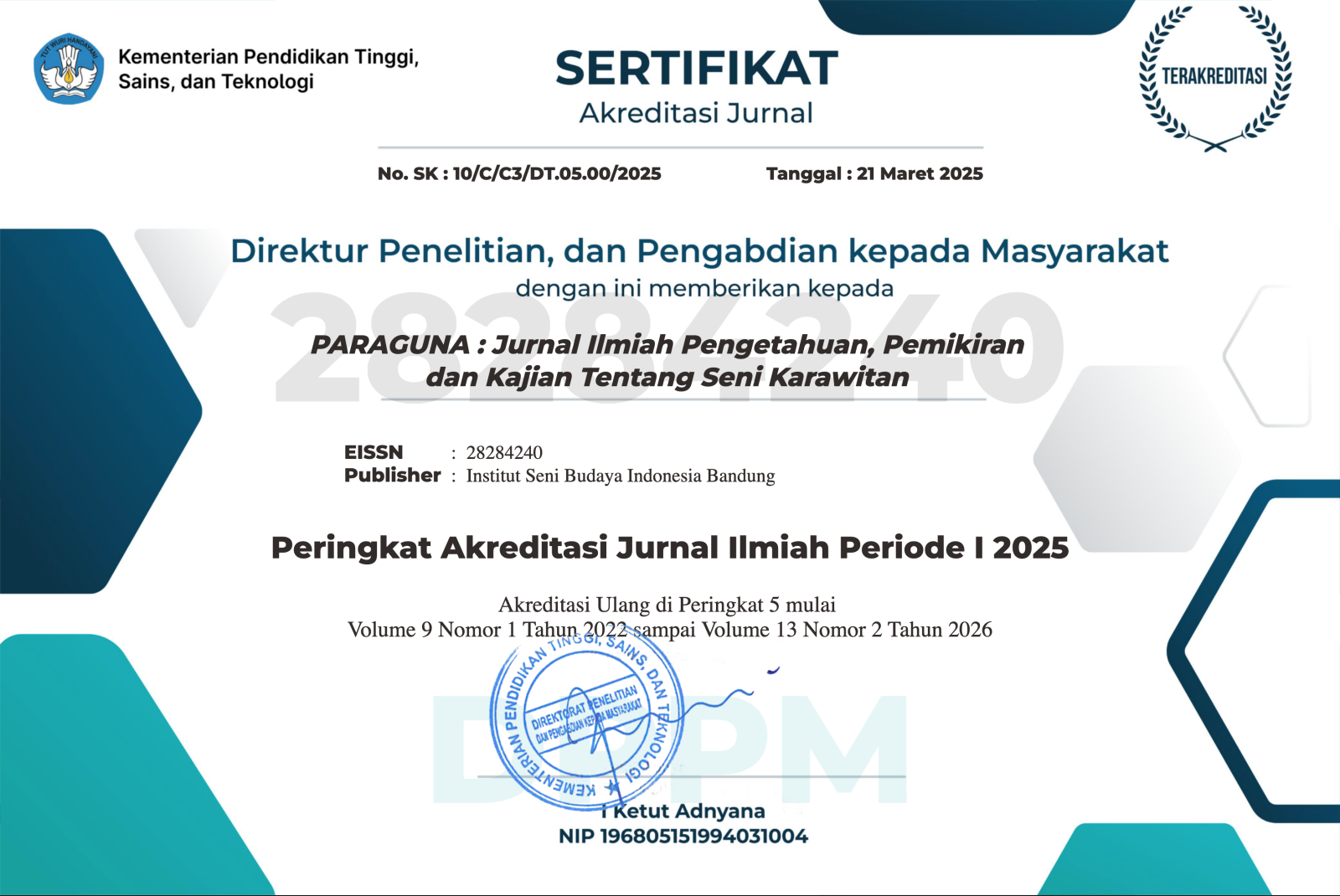ANALISIS NILAI MORAL DALAM LAGU "SI NONA" DALAM PERSPEKTIF MASYARAKAT MINANGKABAU
Keywords:
morals, folk songs, Si Nona, Woman, MeaningAbstract
This research aims to reveal the moral values in the song "Si Nona" which originates from West Sumatra. This song was created by Sjamsu Arifin and popularized by Elly Kasim, describing advice to Minangkabau women to maintain their own and family honor. The research method used is qualitative with semiotic analysis based on Roland Barthes' theory, focusing on the concepts of denotation and connotation. The research results show that denotatively, the lyrics of the song "Si Nona" prohibit young women from leaving the house without a purpose (malala) and don't go to a man's house. Connotatively, this song reflects Minangkabau social norms and customs which expect women to maintain modesty and be societal role models. The song "Si Nona" functions as a moral education tool that reminds women of the importance of protecting themselves and the dignity of their family, as well as teaching traditional values that must be upheld in everyday life.
References
Akbar, M.A. (2014). Analisis Makna Kritik Sosial Dalam Lirik Lagu ”Bento” Dan “Bongkar” Karya Iwan Fals: Kajian Sosiologi Sastra Serta Implikasinya Dalam Pembelajaran Bahasa Indonesia Di SMP. (Skripsi, Universitas Mataram, 2014). Diakses dari http://eprints.unram.ac.id/9470/1/ARTIKEL%20%20MOH.%20ALI%20AKBAR%20%28E1C%20010%20015%29.pdf
Ariesta, Freddy Widya. 2019. “Nilai Moral Dalam Lirik Dolanan Cublak-Cublak Suweng,” Jurnal Ilmu Budaya, Vol. 7 No. 2, 188-192.
Barendregt, Bart. 2002. The Sound of Longing for Home Redefining a Sense of Community Through Minang Popular Music. KITLV, Royal Netherlands Institute of Southeast Asian and Caribbean Studies.
Barthes, R. 2012. Elemen-elemen Semiologi. (diterjemahkan oleh Kahfie Nazaruddin) Yogyakarta: Jalasutra.
Barthes, R. 2007. Petualangan Semiologi. (diterjemahkan oleh Stephanus Aswar Herwinarko) Yogyakarta: Pustaka Pelajar.
Diradjo, Ibrahim Dt. Sanggoeno. 2009. Tambo Alam Minangkabau: Tatanan Adat Warisan Nenen Moyang Orang Minang. Bukittinggi: Kristal Multimedia
Goldman, R. & Papson, S. 2003. “Simulacra Definition”. Information technology. Canton, New York: St. Lawrence University.
https://langgam.id/lirik-dan-makna-lagu-minang-si-nona (diakses 12 Januari 2024).
https://ruangobrol.id/2020/03/09/fenomena/irama-label-musik-pertama-indonesia/ (diakses 25 Maret 2024).
https://sastraminangmodern.blogspot.com/2012/10/lirik-si-nona-dan-lamang-tapai-simbolik.html (diakses 12 Januari 2024).
https://www.discogs.com/release/25835251-Elly-Kasim-Bersama-Orkes-Arsianti-Elly-Kasim-Dengan-Gajana-Jang-Tersendiri/image/SW1hZ2U6ODk0OTI0NjE= (diakses 25 Maret 2024).
Moleong, Lexy J. 2017. Metodologi Penelitian Kualitatif. Bandung: PT. Remaja Rosdakarya.
Nurman, S.N. 2019. “Kedudukan Perempuan Minangkabau Dalam Perspektif Gender,” Jurnal Al-Aqidah, Vol. 11 No. 1, 90-99.
Proborini, C.A. & Luri Santika Ratri. 2023. “Analisis Nilai Moral Dalam Lagu-lagu Tradisional Banyuwangi,” Geter, Jurnal Seni Drama Tari dan Musik Vol. 6 No. 2, 1-9.
Rahmat, Wahyudi & Maryelliwati. 2019. Minangkabau (Adat, Bahasa, Sastra, dan Bentuk Penerapan). Padang: STKIP PGRI Sumbar Press.
Semi, Atar. 1989. Kritik Sastra: Sebuah Pengantar. Jakarta: PT. Gramedia.
Winaldo, Hafiz. 2023. Perkembangan Dan Fungsi Kalason Oto Dalam Budaya Transportasi Masyarakat Sumatra Barat. (Skripsi Institut Seni Indonesia Surakarta, 2023).
Yazid, T.P. 2014. “Representasi Perempuan Minangkabau Dalam Lirik Lagu Si Nona,” Jurnal PARALLELA, Vol. 1 No. 2, 135-142.
Yulia, Novi. 2023. “Elly Kasim Dan Perubahan Sosial: Analisis Lirik Lagu Minangkabau Dalam Album Top Hits (1960-1970),” Jurnal Ceteris Paribus, Vol. 2 No. 1, 7-26.
Downloads
Published
How to Cite
Issue
Section
Citation Check
License
Copyright (c) 2024 dimas dwisepta, Bondan Aji Manggala, S.Sn., M.Sn.

This work is licensed under a Creative Commons Attribution-NonCommercial-ShareAlike 4.0 International License.
- Authors retain copyright and grant the journal right of first publication with the work simultaneously licensed under a Creative Commons Attribution License that allows others to share the work with an acknowledgement of the work's authorship and initial publication in this journal. Authors are able to enter into separate, additional contractual arrangements for the non-exclusive distribution of the journal's published version of the work (e.g., post it to an institutional repository or publish it in a book), with an acknowledgement of its initial publication in this journal. Authors are permitted and encouraged to post their work online (e.g., in institutional repositories or on their website) prior to and during the submission process, as it can lead to productive exchanges, as well as earlier and greater citation of published work.










